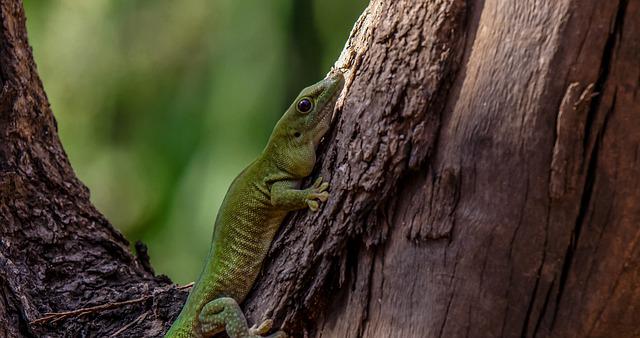While it could be a strange sight, your giant day gecko’s tail falling off is entirely normal. You may wonder, “Do giant day geckos’ tails grow back?” Well, geckos generally do grow their tails back.
While their tails can grow back, it’s not necessarily their original form. That being so, a giant day gecko’s tail may grow back after a month or two. Geckos lose their tails as an escape mechanism when they feel threatened by incoming prey.
There are ways to ensure a healthy tail re-growth for your giant day gecko, such as monitoring it for signs of infection.
Stick around to learn more about giant day gecko tail re-growth.
Why Your Giant Day Gecko is Losing its Tail
You’re carrying your giant day gecko and suddenly notice its tail falling off; there’s no need to panic. This autotomy defense mechanism is used when geckos remove their tails to create a distraction for predators as they escape. The removed tail wiggles and draws attention away from its short leave.
In terms of the anatomy of the tail drop, geckos are reinforced with connective tissue in their tails. These tissues are in the region where the bottom can break off without causing much bleeding since the vessels in the area naturally tighten. With that in mind, here are some possible reasons behind the tail falling off.
Tail is Stuck
Your giant day gecko’s tail could’ve fallen off simply because it got jammed somewhere. In the vivarium, something might’ve fallen on top of its tail. In other cases, there may be tight spaces where your day gecko attempted to wiggle out of but ended up getting their tail stuck.
Infection in Tail
The giant day gecko could be exposed to an illness or specific infection that affected its tail placement. There could be several explanations; for instance, the tail drop may be a symptom of a disease, or it could be directly correlated to it. Either way, you’ll want to take the day gecko to a vet for proper inspection.
Stressful Environment
While feeling threatened by potential predators does induce fear and stress in a giant day gecko, it could be other stimulants. Too much noise or light could frighten the little guy. If your giant day gecko has moved to a different tank, it could result in stress leading to the tail drop.
To avoid this stress, you can try your best to provide your giant day gecko with an ideal environment. Ensure the tank’s temperature, and humidity settings are at an optimal 80 to 75 degrees F and 50% to 70%, respectively.
Reaction to Threats
While giant day geckos can use the distraction mechanism to ward off predators, it may be odd if it occurred in the confines of a safe vivarium. Nevertheless, if there are other geckos in the tank, they may have ganged up on the gecko.
You’ll want to remove the tailless giant day gecko from its enclosure to protect it from bullying cage mates.
What to do When Giant Day Gecko Loses Tail
Although giant day geckos can heal independently, you can assist them with the growth process. Here are a few tips you can follow.
Change Their Substrate
With a broken-off tail, you’ll want to remove any bedding from the tank. The bedding can get caught in their tail region and cause infections. That’s why we suggest resorting to paper towels instead. Just make sure to change the paper towel bedding for hygienic purposes.
Monitor the Tail Drop
After the giant day gecko loses its tail, you’ll want to watch its tailless region. The area could be susceptible to infection. If you notice any signs of contamination, such as swelling, discharge, or redness, we recommend visiting the vet for a closer medical examination.
Increase its Food Intake
On top of monitoring the tail area for infection, you’ll also want to ensure the giant day gecko is usually feeding. In addition to this, you can increase your food intake. This is mainly because the stress from the tail drop could’ve strained your gecko’s fat storage.
You may also want to be cautious when providing live food like crickets. The insect could try to pick at the giant day gecko’s tail drop region. To be safe, you can remove the crickets if they haven’t been consumed after 15 minutes.
Science Behind Tail Re-Growth in Geckos
After figuring out why your giant day gecko’s tail is coming off, you may think, “How does it regrow?” Well, it’s all in the gecko’s spinal cord. This body part of the reptile contains a vast number of stem cells and proteins. These stem cells are called radial glia.
As the tail falls, the tissue formation begins until a newly developed spinal cord emerges. In around 30 days, the tail’s growth is complete. Interestingly, tails aren’t the only body part they can regrow.
According to studies, a gecko’s central nervous system contains regenerative capabilities. They can regenerate their brain cells. Scientists are understandably fascinated by this regrowth ability. They’ve studied the autotomy mechanism and anatomy of geckos and lizards in hopes of applying this ability to human wound healing and overall cell regeneration.
To Conclude
Do giant day geckos’ tails grow back? But, their tails do regrow thanks to their spinal cord cells’ regenerative abilities.
In most instances, your day gecko’s tail may have fallen off due to feeling threatened, stressed, or scared. Luckily, they can grow their tails back, but it won’t be the same as before.
You can ease the regrowth process by providing an ideal environment for your gecko in terms of temperature and humidity. Plus, you can monitor their tailless part and make sure it doesn’t catch an infection.




